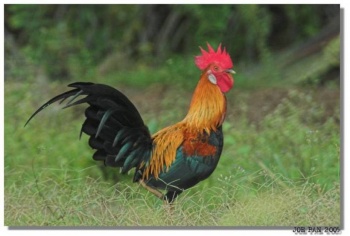
Photo © by Alok Tewari
Pilibhit Tiger Reserve, Uttar Pradesh, India, 27 January 2015
- Gallus gallus
Identification
Male 65–78 cm (25½-30¾ in) ; female 41–46 cm (16¼-18 in)
Male
- Red comb
- Whitish 'eat' patch
- Neck area covered in yellow and bronze feathers
Female has more cryptic plumage for camouflage
Distribution
Northeast India eastwards across southern China and down into Malaysia, Indonesia, and the Philippines.
Borneo is not in their natural range but they were introduced into oil palm plantations of Eastern Sabah. They have since become firmly established and big flocks of them can be commonly seen in plantations in the Lahad Datu,Kinabatangan and other neighbouring districts.
The wild form of this species has been introduced to Hawaii and Fitzgerald, Georgia.
The domestic form of this species has been introduced to Florida, Texas, Hawaii, Niue, Puerto Rico, Australia, US Virgin Islands, British Virgin Islands, and Cayman Islands.
Taxonomy
The name G. g. domesticus is sometimes applied to the domestic form, but no longer considered a valid subspecies. These birds may contain some genes from Gray Junglefowl
Subspecies
There are 5 subspecies[1]:
- G. g. murghi - Northern India and adjacent Nepal and Bangladesh
- G. g. spadiceus - Myanmar to south-western Yunnan, Malay Peninsula and northern Sumatra
- G. g. jabouillei - Northern Vietnam to southern China (south-eastern Yunnan, Guangxi and Hainan Island)
- G. g. gallus - Northern Indochina to eastern Thailand
- G. g. bankiva - Southern Sumatra, Java and Bali
Habitat
Tropical lowland forests, secondary, disturbed, evergreen and deciduous forests and forest edges; open grasslands, scrub, jungle, mangroves, orchards and plantations.
Behaviour
Diet
They are Omnivorous and will eat whatever they happen upon.
Breeding
Females lay an egg every day until reaching a clutch of 12 to 24 eggs which she incubates for 20 to 21 days. Nest is usually on the ground.
Vocalisation
Male advertising call, mainly given at dusk or dawn close to roost, is similar to but shriller and more attenuated than the typical cock-a-doodle-doo call of domestic birds.
Movements
Mostly resident.
References
- Clements, J. F., T. S. Schulenberg, M. J. Iliff, S. M. Billerman, T. A. Fredericks, B. L. Sullivan, and C. L. Wood. 2019. The eBird/Clements Checklist of Birds of the World: v2019. Downloaded from http://www.birds.cornell.edu/clementschecklist/download/
- McGowan, P.J.K. & Kirwan, G.M. (2020). Red Junglefowl (Gallus gallus). In: del Hoyo, J., Elliott, A., Sargatal, J., Christie, D.A. & de Juana, E. (eds.). Handbook of the Birds of the World Alive. Lynx Edicions, Barcelona. (retrieved from https://www.hbw.com/node/53485 on 25 January 2020).
- BirdForum Member observations
- Callaway, E. (2016) When Chickens go Wild. Nature 529(7586):270-273 DOI: 10.1038/529270a
- Pratt, H.D., Bruner, P., and Berrett, D.G. (1987) A Field Guide to the Birds of Hawaii and the Tropical Pacific. Princeton University Press.
- Pyle, R.L., and P. Pyle. 2017. The Birds of the Hawaiian Islands: Occurrence, History, Distribution, and Status. B.P. Bishop Museum, Honolulu, HI, U.S.A. Version 2 (1 January 2017) http://hbs.bishopmuseum.org/birds/rlp-monograph/
Recommended Citation
- BirdForum Opus contributors. (2025) Red Junglefowl. In: BirdForum, the forum for wild birds and birding. Retrieved 28 April 2025 from https://www.birdforum.net/opus/Red_Junglefowl
External Links
GSearch checked for 2020 platform.1





